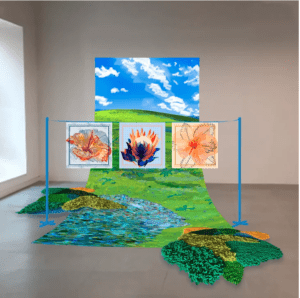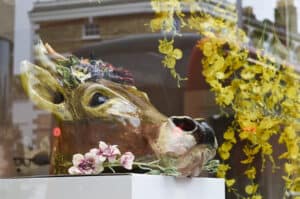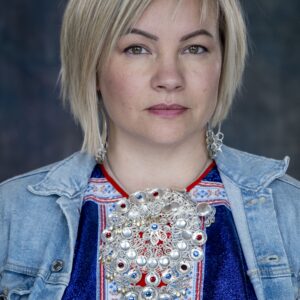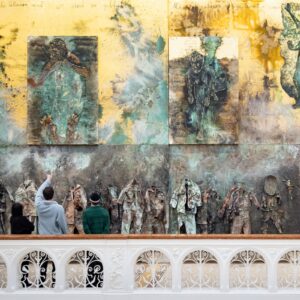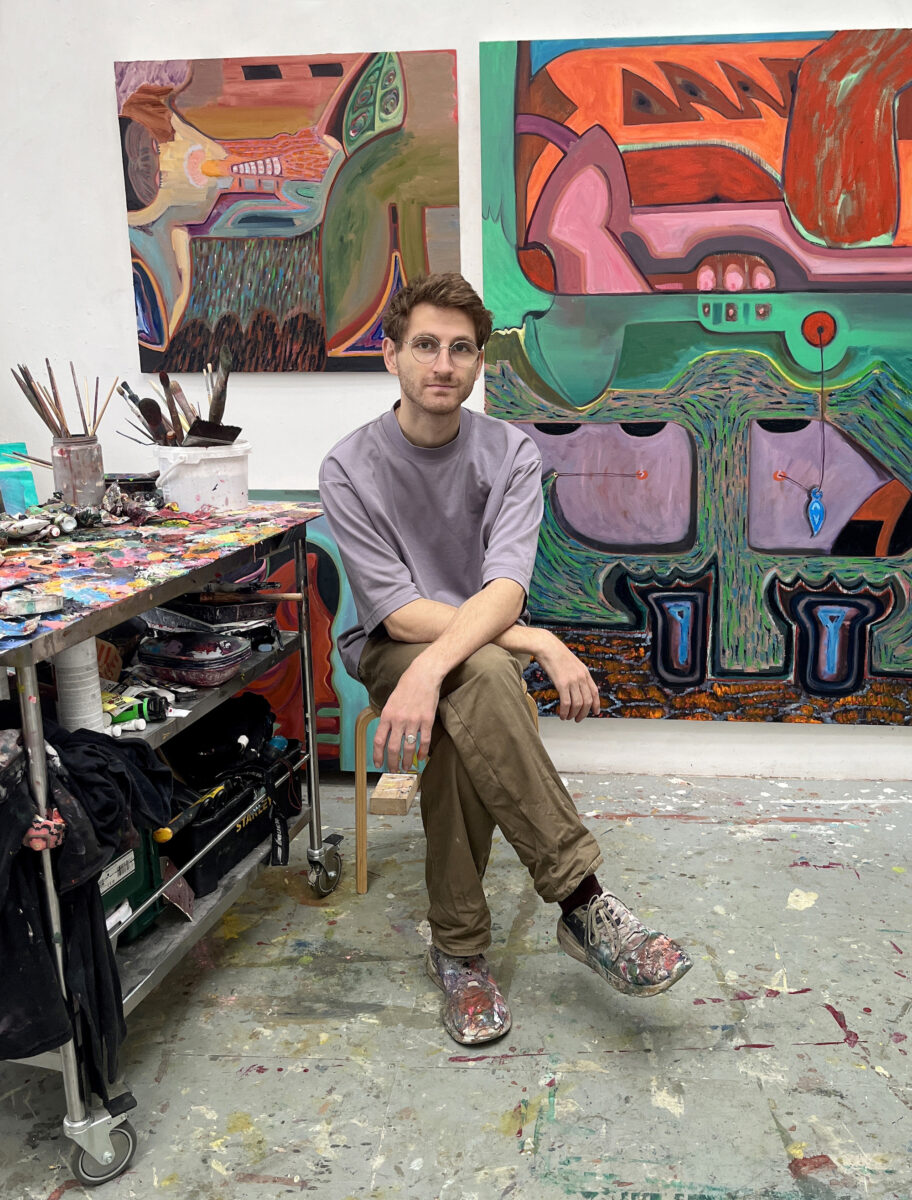
London-based Hungarian artist Andras Nagy-Sandor creates semi-abstract paintings rooted in themes of masculinity, vulnerability and the body’s relationship with technology. Initially inspired by body-armours as narrative storytelling devices, which simultaneously suggest the idea of a heroic figure while belying the body’s intrinsic vulnerability, the artist has recently expanded his practice to consider the body’s relationship with space more widely.
Titled ‘Hold’, Nagy-Sandor’s recent solo exhibition at Hew Hood Gallery in London was a speculative investigation into the things that hold us. It considered the many vessels we unknowingly inhabit for protection, unpicking subjects such as the clothes we wear, the homes we live in, the ideologies onto which we pin our hopes and the individuals who support us through life.
Heavily inspired by the artist’s daily cycles through the city, the show pitted our intrinsic sensitivity and porousness against the devices we use to sheath ourselves – starting with armour and extending through to its contemporary counterparts including cycling helmets, seat belts and waterproof coats. Taking the form of almost impenetrably complex paintings, throughout this body of work Nagy-Sandor weaved webs from symbols and figures that often referenced the Hungarian folktales his mother told him as a child, while also commenting on the contemporary environments we occupy.
Predicated on the artist’s love of storytelling, Nagy-Sandor’s works are commanding and cryptic. They invite the viewer to spend considerable time decoding hidden narratives, eventually offering them the chance to enter the sci-fi, mythological and otherworldly realm that he so effortlessly creates.
Nagy-Sandor has presented two solo exhibitions with Hew Hood Gallery, and has been mentored by STUDIO WEST gallery through 2023 as part of his runner-up ‘NOW Introducing’ 2022 award. His work has been featured at the London Art Fair by Artistellar Gallery, and been included in multiple group shows in London and the wider UK.

Bella Bonner-Evans: Your second solo exhibition with Hew Hood Gallery, ‘Hold’ opened on the 2nd of November 2023. Tell us more about this show. What was it like to work on and what did the show entail?
Andras Nagy-Sador: ‘Hold’ explored the feeling of being held by someone or something – perhaps a person, a structure, a concept or an ideology. It was about fitting in and being a part of something bigger than oneself. The show came from a personal process of cultivating a deeper awareness of the things that hold me – my support structures. I realised that I experience my life indirectly through these things, as if they are a shield I have built for myself.
When making the work, I was asking myself: where do I end? Notions of embodied sensemaking became increasingly important in my process and my conceptual approach to subject matter. I ended up with Cartesian dilemmas, which I attempted to explore, even resolve, through the lens of folklore, sci-fi, animation, fashion (body armours and military), technology and ultimately: paint.
While working on this show, I was also co-producing an artist comic book with my dear friend and collaborator Karoly Tendl. This project really helped me to imagine my works as part of a larger world visually, conceptually and emotionally.
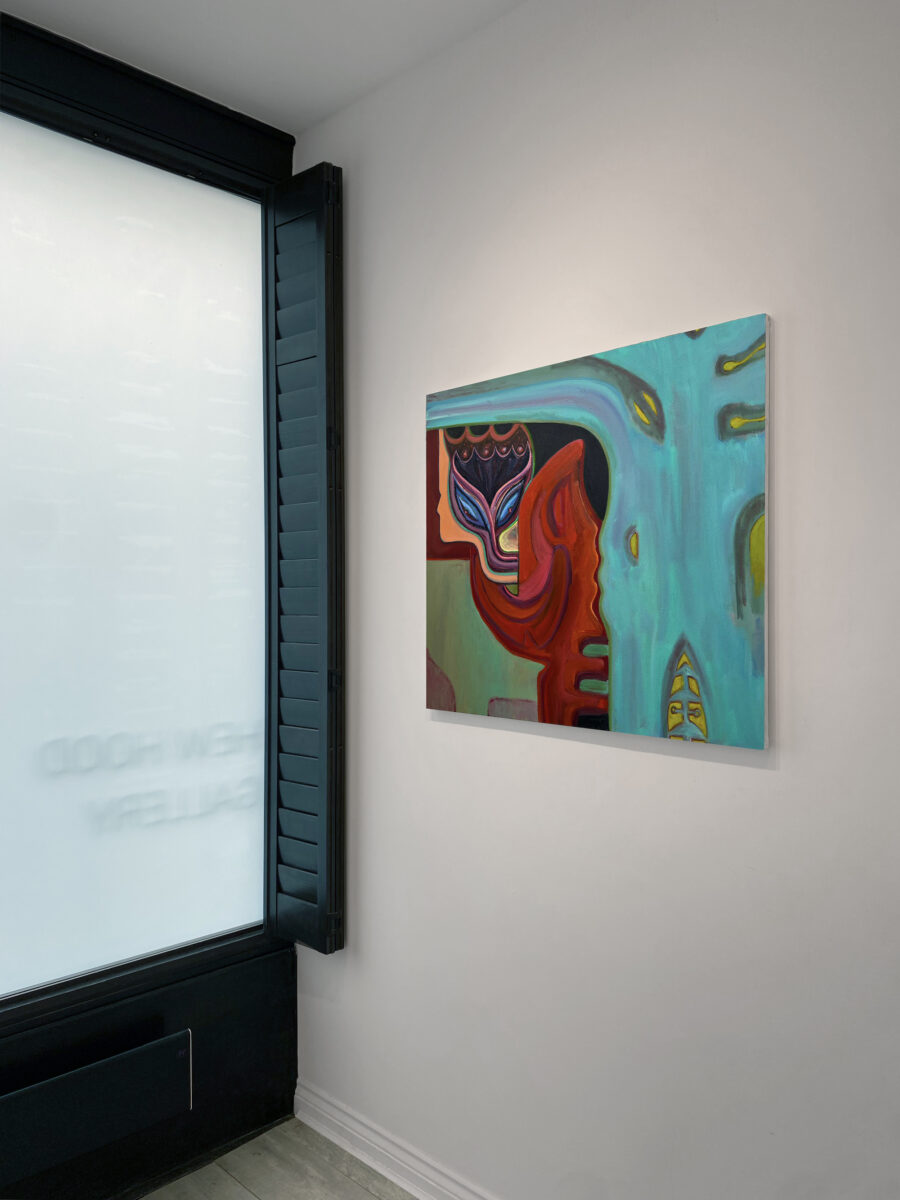
B.B.E: Conceptually, your work is rooted in themes of masculinity, vulnerability and the bodies’ relationship with technology. You explore this by drawing forms from the tools humans have used to protect their bodies throughout the ages, starting with armour and extending through to its contemporary counterparts – cycling helmets, seat belts, waterproof coats. What is about bodily vulnerability that fascinates you, and where did this idea come from?
A.N.S: I am really drawn to the idea that our bodies are imperfect machines. This implies a hybridity that I think accurately describes embodiment in our pre-cyborg age. The way in which we connect to, and adapt our bodies to best fit, our surroundings belies the fact that we experience our bodies as both physically and mentally vulnerable.
How we design our environment, the things we wear, our tools and technologies are indicators of our needs, wants and internal lives. The fears of a particular community are revealed by the defence mechanisms they created for themselves. In this way, certain objects like armours become storytellers. They are manifestations of both the individual and the collective imagination that created them.
B.B.E: Armour is often associated with the hyper-masculine as exemplified by historic tales of strong knights riding fearlessly into battle. How does your work relate to tropes of masculinity as affiliated with heroism, power and control?
A.N.S.: I am in love with armours! They are charged to the brim with narrative and exemplify a pygmalion-like relationship to the human body as something which is both powerful and fragile.
I approach masculine identity from a personal and critical angle in my practice. Tropes of heroism and martyrdom have been widely problematized, yet I think most mainstream criticisms fall short. I really relate to Nietzche’s commentary on ascetics and martyrs in ‘Human, All Too Human’ and, like him, I question the selflessness inherent within heroism.
In my painting, I move between figuration and abstraction which allows me to meld soft, fragile moments together with more industrial, rigid and structural shapes. In this way, I am able to build a dialectic between the human and the non-human, the strong and the weak, the sturdy and the fragile.
B.B.E: Recently, you have been exploring bodily experiences in more depth, in particular the concept of embodied sensemaking whereby individuals naturally extend their awareness into objects as they use them. A car, for example, becomes an extension of the self as one drives it. Can you talk a little about your interest in this idea and the ways in which it informs your work.
A.N.S.: Ever since I started painting, I have been interested in where a painting might end or what might happen between paintings. Compositionally, a lot of elements in my paintings could extend beyond the borders of the canvas – I crop them in very specific ways to imply that the painting is just an element or a moment within a larger, connected whole.
A lot of my ideas surrounding embodied sensemaking come from an MBA Thesis I read, titled ‘The Sea Within: Embodied Sensemaking Among Seafaring Leaders’ by Bradley Edward Roberts. It is basically an investigation into maritime safety protocols. What really captured me about this text was the fact that people working on oil rigs or ships have a fundamental understanding of their location and function within the larger body of the rig or ship.
I started applying this thinking to cycling, a daily experience from which I derive a lot of the inspiration for my paintings. Cycling requires me to develop an immediate and intuitive understanding of my environment: for example, by holding the handle bars I should be able to sense the type of gravel I am riding on and therefore know how I should handle a turn. While cycling, I have to simultaneously be aware of several factors: the weather conditions, my mood, my physical aptness, the direction I am facing, the instructions I am receiving from google maps. As such, I have to become one with the bike, I have to know where it starts and where it ends.
Even when I am a passenger on public transport, my mind is trying to understand where I am within the whole – it’s like I experience a connectedness that momentarily prescribes me a role. This way of thinking has ignited a fascination with the way certain spaces are designed, a hand rail, for example, is an invitation to partake.
It might seem strange, but this is how I see my works interacting with each other.
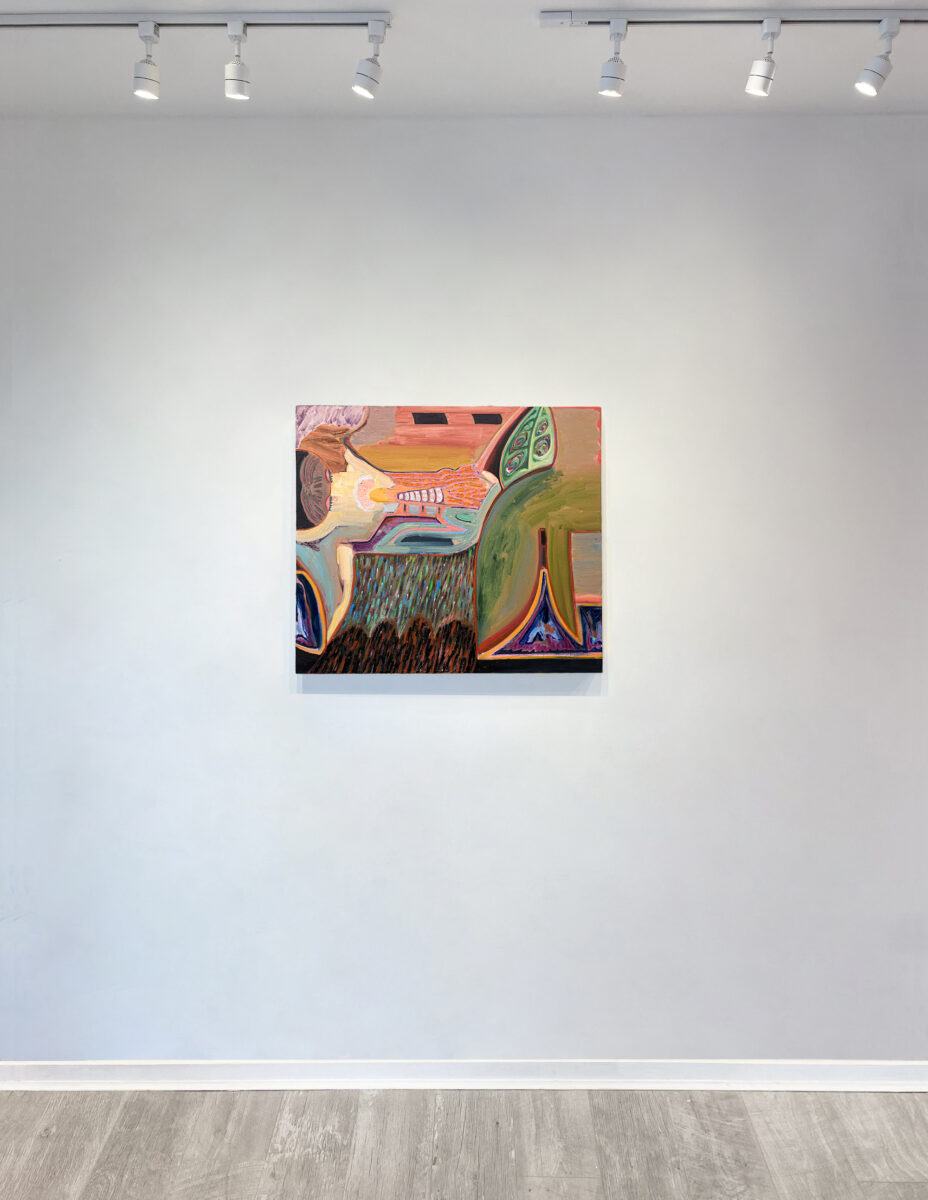
B.B.E.: Tell us a little more about your process and how you construct a work. Do you meditate on concepts behind the works as you paint, or is it a more organic process? Do you work from drawings? Do you consistently use the same materials?
A.N.S.: Each painting is a development of multiple drawings that I intuitively select based on my attraction to elements in them. I begin by physically and sensorially unpicking images from the drawings through painting. As I begin to feel the weight of certain forms within the composition, I start to think about them as story fragments.
I mainly use oil paint and oil bars on canvas and sometimes on paper, which allows me to play with dichotomies such as the organic versus the artificial; or the rigid versus the fluid. These contradictions are very important to me.
B.B.E.: The imagery in your work is, of course, inspired by armours as discussed. What else comes into play and how does it manifest? You’ve mentioned Hungarian folk tales, anime and manga for example.
A.N.S: Armour has always served as an umbrella concept for me, but storytelling is at the core of my work. As such, stories from my childhood and early adulthood have a big impact on how I think, in particular those I observed in animation or comic book format. These narrative-based cultural artefacts have become an intrinsic part of how I approach painting.
Hungarian folktales and folklores are also a constant influence in my work, many of which were shared with me by my mother when I was young. She is a teacher and an ethnographer and she taught me that every object and action in folk law is loaded with meaning. In anime, manga and western comic books, folkloric beliefs and traditions are often translated into contemporary settings while still serving a moralistic function. To me, these are modern mythologies.
I am also always aware that painting has its own history and is embedded in its own tradition, therefore recognisable symbols from other contexts might function differently in this realm where storytelling is translated through mark making, layers, textures and colours.
B.B.E: One of the pieces from your recent solo show with Hew Hood, ‘We Balance You Out’ features a kind of disjointed symmetry with figures either side of a central form. To me, it feels like this work is about relationships, does that resonate with you?
A.N.S: It does. The drawing for ‘We Balance You Out’ was made during the first lockdown in 2020. It is a very personal piece which emerged as I was thinking a lot about how different aspects of my personality manifest within my relationships.
In terms of its visual composition, it plays with symmetry and asymmetry. I love to do something twice on one surface, as in this work, and see how it looks and feels different. In this piece, there is also a kind of multi headed character drawn from folklore and myth. For me, these are symbolic of the way in which we are each complex individuals contained within a singular body.
B.B.E: ‘Hold Our Own’, on the other hand, feels very futuristic, perhaps positioning the viewer within some kind of structure like a car or a spaceship – how do you see this work?
A.N.S: I like that interpretation, especially because one of the key inspirations for this painting was a city that Karoly and I dreamt up for our artist comic book. This imaginary city is not made of buildings and, as such, the idea of private space is reinterpreted. I made the sketch for this work while thinking about how one could feel at home in such a place – How can one fit in if there is no location within a city that can confine or hold them?
B.B.E: Lastly, in what ways did your recent solo show mark a point of development in your practice? And what’s coming up next for you.
A.N.S: This body of work marks the expansion of my practice thematically and visually. I am now beginning a new body of work in a new studio and I cannot wait to continue pushing the boundaries of my practice while also fully exploring every bit of the world that I have uncovered in recent years. I am also currently having some exciting conversations about group and solo projects for 2024.
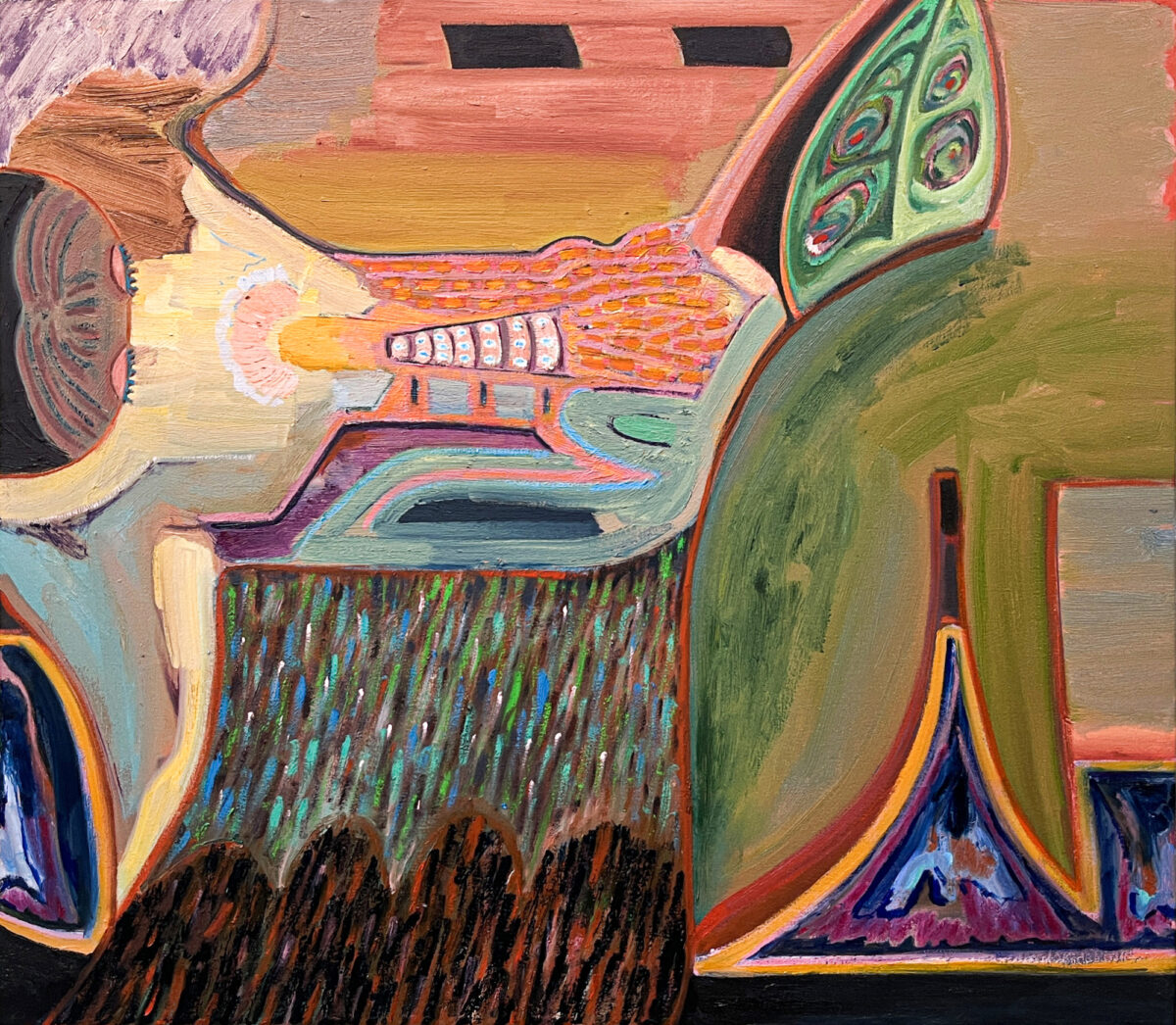
To learn more about Andras Nady-Sandor, follow him on Instagram at @andrasnagysandor or visit his website at www.nagysandorandras.com
